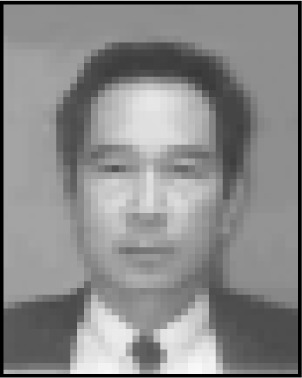Introduction
Clinicians must often decide what do to for an asymptomatic patient who has minimally elevated serum creatinine level. Serum creatinine concentration is used clinically as a convenient index of kidney function, but it is important to remember that even a minimal elevation in creatinine can reflect significantly decreased rate of glomerular filtration. In fact, up to 40% of patients with normal serum creatinine level may have some reduction in glomerular filtration rate.1 Calculation of the glomerular filtration rate is very important to more accurately measure and assess kidney function. We present a typical clinical situation and suggest a possible course of evaluation and treatment.
Case Example
You are evaluating a 55-year-old white woman who has a 14-year history of diabetes mellitus and a 20-year history of hypertension and who previously received treatment for diabetic retinopathy. The patient’s blood pressure measured in the office is 142/88 mm Hg, weight is 156 lb (70.2 kg), most recent blood glycosylated hemoglobin (HBA1C) measurement was 8.2% of total hemoglobin, and most recent low-density lipoprotein (LDL) cholesterol level was 145 mg/dL (3.75 mmol/L). The patient’s current regimen for blood pressure control includes hydrochlorothiazide, 25 mg per day; atenolol, 25 mg per day and clonidine, 0.1 mg twice a day; and for blood glucose control she uses glipizide at 5 mg per day. The patient has no known history of heart disease or congestive heart failure. Result of a serum creatinine test obtained just before this visit is 1.3 mg/dL (114.92 mol/L), which is the same result as that obtained three months earlier. The reference ranges for serum creatinine are 0.7 to 1.3 mg/dL (61.9–114.9 mol/L) in men and 0.6 to 1.1 mg/dL (53.0-97.2 mol/L) in women.
Assessing Renal Function
Because the serum creatinine value is elevated slightly, results of her previous serum creatinine tests should be reviewed, and the test should be repeated if this is the first elevated value noted. The next step is to stage the patient’s renal disease according to recent Kidney Disease Outcomes Quality Initiative (K/DOQI) guidelines.1 Glomerular filtration rate (expressed as mL/min/1.73 m2 of body surface area) can be estimated using the Modification of Diet in Renal Disease (MDRD) formula: 186 (serum creatinine in mg/dL)1.154 (age in years)0.203 (0.742 if female) (1.212 if African American).2 Soon, Kaiser Permanente Southern California clinical laboratories will calculate and report estimated glomerular filtration rate by using this formula. An online glomerular filtration rate calculator that uses this formula can be accessed at the Kidney Disease Outcome Quality Initiative (KDOQI) Web site: www.kidney.org/professionals/kdoqi/index.cfm. Historically, 24-hour urine collection was used to assess creatinine clearance. However, this method is time-consuming and frequently inaccurate because of improper specimen collection. For example, undercollection leads to falsely low estimates of glomerular filtration rate. Accuracy of the MDRD formula is validated, and use of this formula is currently the preferred method for estimating glomerular filtration rate.
Application of the MDRD formula to the data for this patient yields a glomerular filtration rate of 46 mL/min/1.73 m2. According to the most recent guidelines, calculated glomerular filtration rate can be used to classify chronic kidney disease into five stages (Table 1);1 the chronic kidney disease in the case example is at stage three. Despite minimal elevation in serum creatinine level, the patient has moderate reduction in glomerular filtration rate. Reduced glomerular filtration rate warrants investigation of potential causative or contributive factors, including chronic medical conditions, prescription or over-the-counter medication, and urinary tract obstruction. The chronic conditions most commonly associated with decreased glomerular filtration rate are hypertension or diabetes. Medication use should be carefully reviewed, particularly use of nonsteroidal anti-inflammatory or other nephrotoxic medications, and less-nephrotoxic agents should be substituted when possible. The patient’s medical and family history, physical examination findings, and symptoms (if any) should be evaluated for evidence suggestive of obstructive nephropathy.
Table 1.
Stages of chronic kidney diseasea on the basis of glomerular filtration rate
| Stage | GFR (mL/min/1.73 m2 body surface area) | Description |
|---|---|---|
| 1b | ≥90 | Normal GFR |
| 2b | 60–89 | Mild ↓ GFR |
| 3 | 30–59 | Moderate ↓ GFR |
| 4 | 15–29 | Severe ↓ GFR |
| 5 | <15 or dialysis | Kidney failure |
GFR, glomerular filtration rate.
Chronic kidney disease is defined as disease that persists ≥3 months
Stage 1 and 2 require a marker of kidney disease: proteinuria hematuria, or an anatomic abnormality
Adapted and reproduced by permission of the publisher and author from: National Kidney Foundation (NKF) Kidney Disease Outcome Quality Initiative (K/DOQI) Advisory Board. K/DOQI clinical practice guidelines for chronic kidney disease: evaluation, classification, and stratification. Am J Kidney Dis 2002 Feb;39(2 Suppl 1):S1–246.1
The next diagnostic procedure is urinalysis to screen for hematuria and proteinuria. The K/DOQI guidelines accept use of a standard urine dipstick to screen for proteinuria:1 Proteinuria of 1+ or higher requires further quantification and confirmation.
The K/DOQI guidelines recommend using an untimed (“spot”) urine sample to determine the albumin-to-creatinine ratio instead of using the traditional timed (eg, 24-hour) urine collection method.1 Results of urinalysis from a spot sample can be used to accurately estimate daily urinary albumin loss. A first-morning-urine specimen is optimal, but a random urine specimen is also acceptable. If the magnitude of proteinuria is within the nephrotic range (ie, >3 g/d), referral of the patient to the nephrology department should be considered. If the patient has subnephrotic-range proteinuria (ie, <3 g/d), angiotensin converting enzyme (ACE) inhibitors (such as lisinopril) or angiotensin II receptor blockers (such as losartan) should be prescribed unless contraindicated, and the dosage should be adjusted according to the patient’s blood pressure response. Serum potassium and creatinine levels should be checked about 7–10 days after the patient begins taking any of these medications; up to 30% increase in serum creatinine level is often seen within this time period and is not an indication to discontinue medication use. These medications will reduce proteinuria while providing a renal protective effect and are especially important in patients with diabetic nephropathy. If the patient is unable to take these medications, a nondihydropyridine calcium channel blocker such as diltiazem or verapamil should be prescribed. These medications reduce proteinuria but are considered second-line agents.
For this case example, results of urinalysis show proteinuria (1+) without hematuria, white blood cells, or casts. Follow-up urinalysis of a spot sample show an albumin-creatinine ratio consistent with urine protein loss of 1.2 grams per day.
Slowing Progression of Renal Disease
For patients with decreased kidney function, measures to reduce or retard the progression of renal disease such as control of hypertension, hypercholesterolemia, and hyperglycemia should be emphasized. The target blood pressure for any patient with chronic kidney disease should be ≤130/80 mm Hg;3 for patients with urine protein loss of more than 1 gram per day, the target blood pressure should be ≤125/75 mm Hg.4 The target LDL cholesterol level should be ≤100 mg/dL (2.6 mmol/L),5 and the target HBA1C should be ≤7% of total hemoglobin.5
This patient began taking lisinopril at a dosage of 10 mg per day, and the dosage was adjusted to achieve her target blood pressure. The proteinuria was requantified three months later, and urine protein loss had decreased to 0.3 grams per day. The patient was counseled on the importance of blood glucose control, and the glipizide dosage was adjusted to achieve the target glycosylated hemoglobin value. She eventually began taking lovastatin and made dietary and lifestyle modifications to reach the target LDL cholesterol level.
Summary
As this case demonstrates, even a slightly elevated serum creatinine level can indicate presence of clinically significant kidney disease. Therefore, calculated glomerular filtration rate, instead of absolute serum creatinine level, should be used to evaluate kidney function. If nephrotic-range proteinuria is present or if the patient has other indications of renal disease, such as red blood cells or casts in the urine sediment, referral to a nephrologist should be considered. Patients with any degree of chronic kidney disease should have their blood pressure, blood glucose level, and blood cholesterol level managed aggressively to help reduce or prevent the progression of kidney disease as well as to reduce risk of cardiovascular events.
Acknowledgments
Woldemariam Gebreselassie, MD, and Mohammed Idroos, MD, reviewed the manuscript.
Biographies
Antoine C Abcar, MD, is a staff nephrologist at KP Los Angeles. He did his residency in Internal Medicine and Fellowship in Nephrology at KP Los Angeles Hospital. E-mail: antoine.c.abcar@kp.org.

Larry Chan, MD, is a nephrology fellow at Kaiser Permanente Los Angeles Medical Center. E-mail: larry.l.chan@kp.org.

Hock Yeoh, MD, has been with Kaiser Permanente in the Los Angeles Medical Center since 1975. He is an assistant to the Associate Medical Director of Operations, SCPMG, and is also actively involved in the chronic kidney disease (CKD) and end stage renal disease (ESRD) programs. E-mail: hock.h.yeoh@kp.org.

This poster (circa 1943), with its vigorous message that signing up for the Health Plan will actually help to keep you as robust as this shipbuider figure might well be the first “health maintenance” offer of what would become Kaiser Permanente and the model for Health Maintenance Organizations.
Courtesy of the University of California’s Bancroft Library. This “Moment in History” was collected by Steve Gilford, KP Historian.
References
- 1.National Kidney Foundation (NKF) Kidney Disease Outcome Quality Initiative (K/DOQI) Advisory Board K/DOQI clinical practice guidelines for chronic kidney disease: evaluation, classification, and stratification. Am J Kidney Dis. 2002 Feb;39(2 Suppl 1):S1–246. [PubMed] [Google Scholar]
- 2.Levey AS, Bosch JP, Lewis JB, Greene T, Rogers N, Roth D. A more accurate method to estimate glomerular filtration rate from serum creatinine: a new prediction equation. Modification of Diet in Renal Disease Study Group. Ann Intern Med. 1999 Mar 16;130(6):461–70. doi: 10.7326/0003-4819-130-6-199903160-00002. [DOI] [PubMed] [Google Scholar]
- 3.Chobanian AV, Bakris GL, Black HR, et al. National Heart, Lung, and Blood Institute Joint National Committee on Prevention, Detection, Evaluation, and Treatment of High Blood Pressure. National High Blood Pressure Education Program Coordinating Committee The Seventh Report of the Joint National Committee on Prevention, Detection, Evaluation, and Treatment of High Blood Pressure: the JNC 7 report [published erratum appears in JAMA 2003 Jul 9;290(2):197] JAMA. 2003 May 21;289(19):2560–72. doi: 10.1001/jama.289.19.2560. Epub 2003 May 14. [DOI] [PubMed] [Google Scholar]
- 4.Peterson JC, Adler S, Burkart JM, et al. Blood pressure control, proteinuria, and the progression of renal disease. The Modification of Diet in Renal Disease Study. Ann Intern Med. 1995 Nov 15;123(10):754–62. doi: 10.7326/0003-4819-123-10-199511150-00003. [DOI] [PubMed] [Google Scholar]
- 5.Kaiser Permanente Southern California Clinical practice guidelines: chronic kidney disease (CKD) Available from: http://wpsapp15.crdc.kp.org/pkc/scal/cpg/cpg/html/CKD.html (accessed December 11, 2003).



